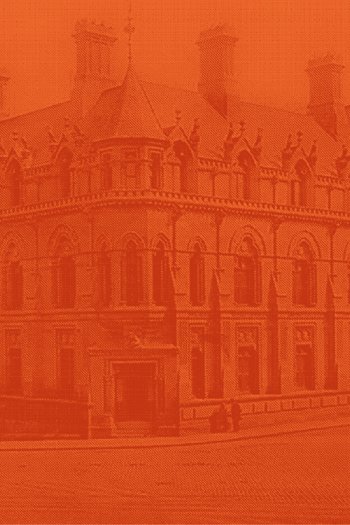You’ll learn:
- About Neville Hall’s evolution through the years The nature of this historic building’s careful restoration
- How the various spaces that Neville Hall offers will be used by stakeholders and the wider community
Restoration of Neville Hall, the home of The Common Room, has been a thoroughly enjoyable and memorable project. The building sits on a signifi- cant corner adjacent to Newcastle railway station and is part of a collection of buildings including Wood Memorial Hall and the Neville Hall building itself.
I was appointed in 2017 as conservation architect and interior designer to work with The Common Room to wake up this sleeping giant.
The Grade II* listed property was showing serious signs of neglect and could have easily moved to a building in advanced decay. Over the years, lack of maintenance and previous occupiers had affected the building fabric.
My brief was to look at Neville Hall, discover how it was put together and evaluate what was so important about this important building of more than special interest. The building has a real soul and character but had been modified and altered through the late 20th century, with some awful additions and features.
My task was to remove the unwanted additions, restore the historic proportions of the rooms and create a new core that would allow the building to have modern toilets, stairs and lift facilities.
A Sympathetic Redesign
We inherited a concept design but reworked this proposal to create a solution that was more sympathetic to the original building and yet exciting and dynamic.
I had to work out how to get full disability access into the building, open all the major spaces and create a suite of new offices to fit into the old external courtyard. The building was also cold, dark and unwelcoming which meant a key element of the design strategy was to improve the heating and make it welcome, warm and light. So, a real challenge was handed to me.
My interiors brief was to reflect the heritage and history of the building and bring this up to date in the design, colour, lighting and furniture to be picked.
The proposed design became a terrific three-dimensional puzzle with the creation of a new central core that grows through the building and out of the roof, hidden behind the slate roofs, giving fantastic views of the city. Each of the existing elements of the building was researched and we learnt so much about its history and original function.
The design for the building restoration was conceived in two parts. The first, Neville Hall, occupies the northern part of the footprint. It is arranged over three floors set around a large and impressive central staircase. Originally, the rooms were designed to be let commercially and face west and north, overlooking the main street. We sought to restore them in their footprint and hierarchy.
The second element is the Wood Memorial Hall which is located centrally within the building. This houses a magnificent three storey high gothic Victorian library to celebrate engineering. We had early meetings in this room and I have never been so cold in my life. This room needed no major interventions, just careful reawakening with improved lighting and insulation and its beautiful stained glass cleaned and restored.
The lecture theatre was built last in the building by excavating out in the ground and basement – well it is the former Mining Institute! This intimate curved room made from Cuban mahogany has now been updated and is the perfect lecture and performance space. It has become a super entertainment venue for a wide variety of functions.
Surrounded by History
During the works, we encountered Hadrian’s Wall running to the front, along the railings. What we found was excavated and recorded, along with further archaeological finds inside the building, tracing the foundations of previous buildings discovered on the site.
Given the historic nature and design complexities of the building, it was important to achieve high levels of cooperation with the planning and conservation teams at Newcastle City Council as well as The Victorian Society and advisers at Historic England. All were heavily involved in the design process and worked closely with Howarth Litchfield to achieve the result.
The exterior of the building has been subject to a thorough programme of refurbishment works to include masonry repairs, timber window refur- bishment, stained glass repairs and slate roof refurbishment to restore the building to its former glory. The wonderful stone chimneys are now fully restored and rebuilt and help to hide the new offices and plant on the roof.
The building today provides first class conferencing and banqueting facilities as well as an awe-inspiring venue for weddings and celebrations. The café bar offers the perfect location for a casual coffee, after work drinks or pre-dinner meeting place.
New Life, new Opportunities and a new Owner
This has been a hugely ambitious and exciting project which will play a key role in ensuring the sustainability of this area of the city. It provides a model on how to preserve and adopt old buildings. Old buildings need using and the love of a caring owner. Neville Hall has that.
I have been fortunate in my career to have worked on many wonderful listed and special buildings. I believe the skill in restoring these wonderful old buildings is to research and understand them, and in particular how they were intended to be used. Only then can you suggest alterations and amendments that are sympathetic, bold and ingenious.
Newcastle now has a restored elegant building sitting proudly on the corner of the street. It no longer hides away but stands proud with its chest out. A perfect example for the restoration of our built environment in the city centre.
Bio
Neil Turner has 30 years’ experience as an architect. Having worked in a range of practices both in Britain and abroad, he joined Howard Litchfield in 1991 and became a director in 2006.
He is a qualified design project manager, client design advisor and conservation architect, as well as a member of the North East Regional Design Panel.
An award-winning architect for both conservation and modern architecture, Neil has a national reputation in the conversion and transformation of listed buildings. He has successfully worked across a huge range of buildings for charities, churches, private clients, local authorities, universities and schools.
He is known for his expertise on sustainable design solutions, energy conservation and historic conservation works. Neil designed his own award-winning house in the Tyne Valley and is a keen artist, runner and family man.


